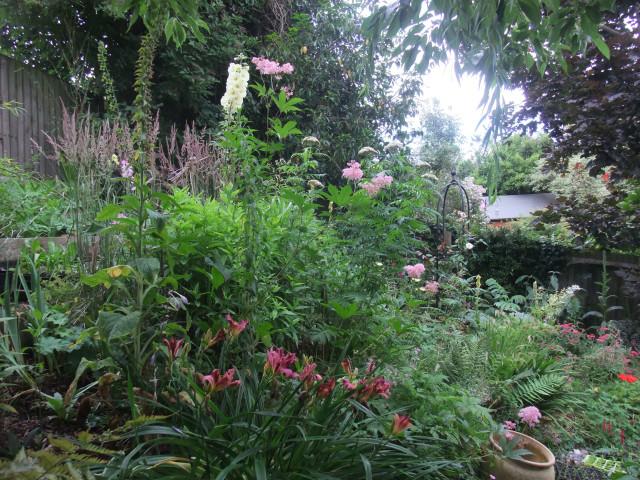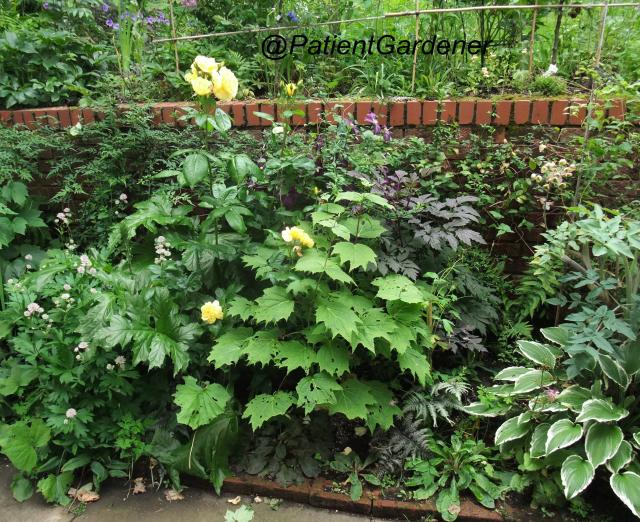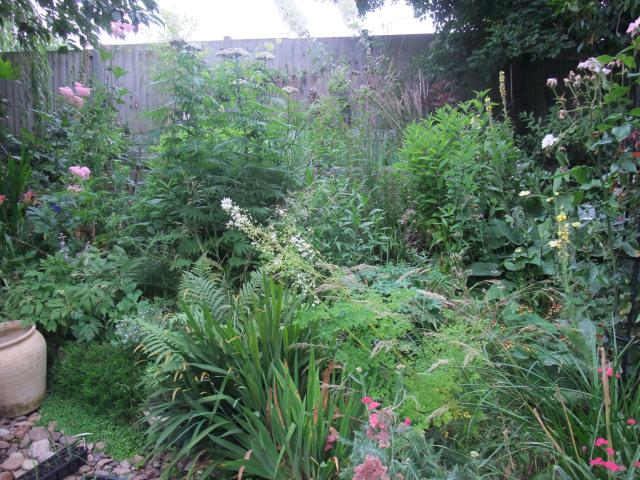
My overgrown slope with a late summer focus and lots of textures
This post is written in response to the latest prompt from the Grow Write Guild. We were asked to write about what inspired us to garden, or who our mentor was.
I don’t have a gardening mentor and I don’t really remember anyone in my past being very garden focussed. I remember my parents clearing overgrown gardens so we spent a lot of time outside but they have a tendency towards lawn so that can’t have fueled my passion. I remember spending time with my aunt’s mother who had a small greenhouse and being fascinated by it but I don’t remember gardening with her so I have no idea where my passion comes from.
I am self-taught, I read lots of horticultural literature and over the years have picked up tips from various television programmes and a few day schools I have attended but I have had no mentor. However there are writers who inspire me and I have pondered on this post trying to decide who I would like to be my mentor if I could choose and meet that person in real life. My first choice was Christopher Lloyd, fairly obvious and I love his writing and his passion but I think he would be too intimidating as a mentor and my confidence is a fragile thing. Also whilst I like his style and his ‘I’ll do what I want’ approach I’m not so keen on some of his planting. I used to think I liked the big tropical look but actually deep down inside I am a true English girl and I like the cottage garden look far more.

The patio border – its late summer appearance, it also has lots of spring bulbs
However, I have discovered someone else who I can completely relate to and whose book, he has written only one, encouraged me hugely last year. David Culp is an American horticulturist and gardens in Pennsylvania. He wrote a book called The Layered Garden which I reviewed last year. Like Lloyd and others his approach is to build up the borders with layers and not just the border the garden. So whilst each border has one or two seasons of interest when it isn’t at its peak it still looks good. He gardens around the year and his book spoke to me as he not only loves plants but the same plants as me. His garden is romantic, lush and quite wonderful – well if the photographs are to go by.
He made me start to think about how you use plants. Yes he collects plants but he also understands about how to create a garden with them and how to show them at their best. Planting so one plant picks up on the colouring of its neighbor or contrasts with the textures etc and this is something I am now trying to do. I found his approach liberating, he states that you should garden for yourself. You should forget about the current trends and what the neighbours will think. “Experiment, play with colours, do what pleases you, and do not be afraid to change things if you wish.” He talks at one point about how his grandmother when he was small planted a bed with hot and spicy coloured plants which was against the norm and how it had an impact on him at the time which has given him the courage in his later life to do what he wanted. He says there is no rule book when it comes to planting, “Some gardeners get so hung up on all the “rules” that have been laid down by so many “experts” that they are constantly wondering, “What am I doing wrong”? My first rule for designing a garden is that there are no rules….” and I find this quite exhilarating.

Another view of the slope
There is a page in the book where he shows a border when he first creatred the garden and it now. The first picture shows a border which I have to say I would be pleased with and looks a little like mine now (see photos of the slope) – he calls it dull. But rather than be deflated by this I am inspired by the ‘now’ photo which shows a border with many of the same plants: irises, roses, geraniums etc but it is alive and exuberant because he has incorporated some fluffy grasses, architectural Phormium and there is a repetition to the planting and the colours. Not only does he look at the contrast or harmony of colours but also their values and as someone who has spent time painting this makes sense to me.
I spend ages peering at the photographs. I really wish I had the book electronically so I could enlarge them and peer closer. There are archetypal herbaceous borders but with a twist, collections of pots, a gravel garden, a shady slope, a hellebore garden and rose beds.
Not only does David advocate an approach I aspire to achieve and which I admire hugely but he is a plant collector with passions for snowdrops, hellebores, narcissus, epimediums and many more. Here is someone who has found a way to collect the plants he loves but to also create a garden with them which has a cohesive appearance and not a hotch potch as my garden had begun to turn into.
Having read David’s book last year I took a different approach to planting the front garden. I thought about the structure of the borders as well as how the plants interplay and picked up on each other. I have still got a very long way to do but I am pleased with the results already and I am finding that I am looking at the plants I love differently and my garden is benefitting from it.
So whilst I might not have, or have had, a real life mentor I am currently inspired by David Culp – his book makes me think but also makes me feel that the look I long to achieve is within my grasp.

